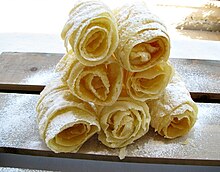Fazuelos
This article needs additional citations for verification. (September 2015) |
 | |
| Alternative names | Fijuelas, hiuelas, deblas |
|---|---|
| Type | Pastry |
| Main ingredients | Flour, eggs |
Fazuelos, also known as fijuelas, hiuelas, deblas, and hojuelas are pastries of thin fried dough. A type of rolled pastry, their origins trace back to Spain, with references dating back to the late Spanish Middle Ages.
Sephardic tradition
[edit]In Sephardic Jewish tradition these pastries, reminiscent of Esther's meguillah due to their characteristic rolled form which recall the shape of Haman's ears, hold cultural significance, particularly during the celebration of Purim.[1][2]
Historically, fazuelos were mentioned in literature, notably in Francisco Delicado's La Lozana Andaluza, where a Jewish woman named Aldonza reminisces about preparing the pastry while living in Andalusia, fleeing persecution from the Spanish Inquisition. Fazuelos are also made by non-Jewish communities, especially during the Christian festival of Semana Santa (Holy Week), which coincides closely with Purim. This cross-cultural adoption of the pastry is evidenced by its inclusion in some Christian Spanish cookbooks as early as 1599.[2]
Tunisia
[edit] A plate of Oudnin el kadhi | |
| Course | Dessert |
|---|---|
| Place of origin | Tunisia |
| Main ingredients | flour, oil, sugar, honey |
Oudnin el kadhi or wdinet el cadi (آذان القاضي "Judge's ears"[3] in Arabic) are a type of pastry commonly found in Tunisia.
Preparation
[edit]Writing for Tablet Magazine, food historian and renowned authority on Sephardic cuisine Hélène Jawhara Piñer provides a recipe. Comprising flour, eggs, sugar, and oil, the dough is rolled thinly, cut into strips, and briefly fried. A syrup of water, orange blossom, and sugar is then prepared for additional flavor. The fazuelos are then garnished with sesame seeds or icing sugar.[2] Turkish Jews add brandy to the dough and Moroccan Jews eat them with cinnamon and syrup. They are similar to Andalusian Pestiños, but the latter are eaten with honey.[citation needed]
In Tunisia, flour, eggs, oil, orange flower water, sugar and salt are mixed, and the resulting dough is rolled and cut into strips. These are then dipped in hot oil and rolled around a fork. After draining, they are coated in honey or syrup or sprinkled with powdered sugar. Sesame seeds are sometimes used as topping.[3]
See also
[edit]References
[edit]- ^ Claudia Roden, (2006), The Book of Jewish Food: An Odyssey from Samarkand and Vilna to the Present Day, Penguin Books, p. 592
- ^ a b c Piñer, Helena Jawhara (March 6, 2020). "This Purim, Celebrate with Hojuelas, a Delicious Sephardic Treat". Tablet Magazine.
- ^ a b "Oudnin el kadhi". Khaoula.com (in French).

